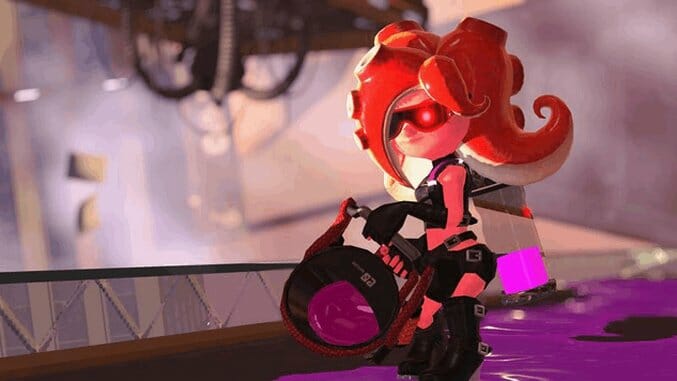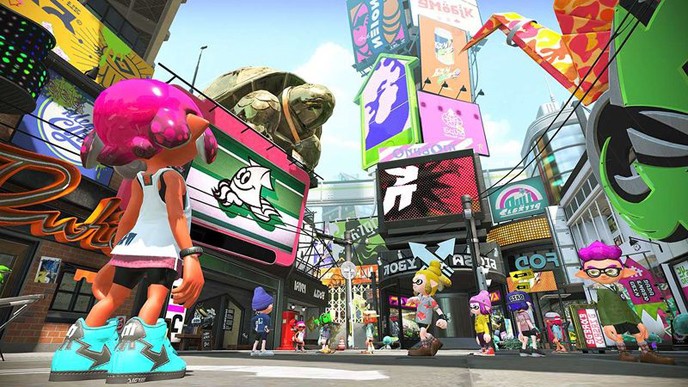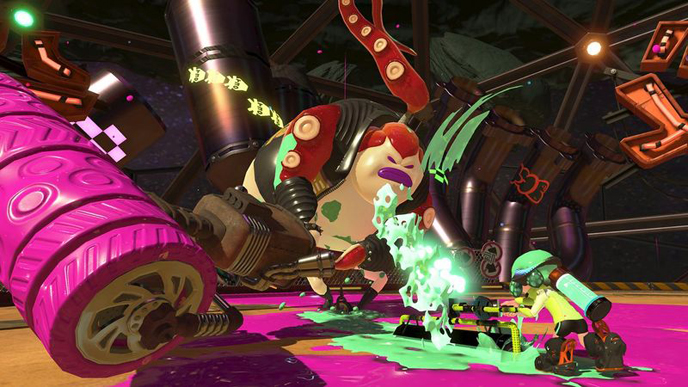Splatoon 2: More Splatoon

Splatoon 2 moves quickly and there’s always a lot going on. Switching between being a squid, swimming and flopping through a pool of ink, and its squat, cartoon human form, happens with a single button push. The trigger that fires paint from various guns, brushes and buckets is held down almost constantly so as to shoot at not just opposing players, but also any surface not already covered in the appropriate color. Everything is rendered loudly, battle arenas are bathed in rich purples and blues, neon greens and oranges. The sounds of splashing paint are carried on the back of frantic pop songs sung by computerized chipmunk voices speaking an invented language.
It’s hard to do with all the noise, visual and otherwise, but if you slow down a bit and consider the component parts of any few seconds of Splatoon 2, it shows an extraordinary level of craft. There’s the instant burst of pleasurable feedback that comes from sloshing paint—color, sound, and minute controller rumble—onto walls, ground or enemy, repeated thousands of times per match. There’s the simple push and pull of a game whose primary multiplayer mode makes simply coloring in swathes of the level as important as taking down enemy players. There’s the subversive thrill of a shooter replicating the excitement of its genre peers by swapping headshots for paint drenching, channeling the primal joys of violent combat into coloring book battles that gain rather than lose power in being so innocuous.
Splatoon 2 is, at its core, a beautifully made game. If a description of what makes it so great sounds familiar, though, it’s because it’s a retread of pretty much the exact same formula that made its 2015 predecessor a great game, too. More a rehash than anything new, Splatoon 2 consists almost entirely of slightly better-looking iterations of what’s come before. Once again, the player creates a squid/human hybrid, hangs out in a postdiluvian, Superflat-inflected version of a downtown Tokyo street, throws millions of liters of paint at everything around her, and uses the cash earned in never-ending turf wars to buy new clothes and weapons that make her both better at fighting and, more importantly, increasingly stylish when in human form.
The single-player mode is, like before, a cursory diversion. Each level offers variations on a common theme, highlighting tactics for taking down enemies with a wide array of weapons and learning the intricacies of navigating environments as both squid and human through simple puzzles. The stages are imaginatively designed gauntlets filled with impossible, floating architecture and tentacle monsters that provide a good excuse to get a handle on Splatoon 2’s different guns and movement systems before competing against real players, but the challenges are limited and too similar from level to level to be worth much for their own sake. The only real highlights are the boss fights—one-on-one battles against typically enormous, wonderfully bizarre creatures—that cap off each of the five areas the player works through. (The best stars a samurai octopus wearing a leather vest who rides around a circular floating platform on a paint-spreading unicycle.)
As in the past, it’s Splatoon 2’s line-up of multiplayer modes that make the best use of its foundation. Again, though, they’re nearly identical to those featured in the original game. Turf War returns, which is still the clearest distillation of what makes Splatoon great. In it, two teams compete to cover the largest percentage of a level with their group’s designated color of paint. It becomes a constant give and take between deciding whether to concentrate on taking out enemies so as to have greater control over the map or ignore them for a time, throwing ink that allows the team to travel faster as squid (and slow opponents down) and increase their territory. Ranked matches open up different varieties of competition, including a king of the hill territory capture mode and two spins on capture the flag (in one, players fight for control of a moving platform; in the other, a special weapon). Though there are new maps—and weapons and clothes to bring into them—each style of online play is essentially the same as it was in the first Splatoon. They all offer fantastic explorations of the game’s foundations. They all feature meticulously designed spaces and simple, approachable rule sets that still allow and encourage dedicated players to form unique strategies. It’s just a shame they’re only really updated versions of what came before.
The biggest departure from the first game’s formula comes with Salmon Run, a co-operative mode that asks up to four players to fight waves of mutated fish and gather the eggs dropped by their leaders (essentially one of seven different types of boss creatures). Set up as an under-the-table fishing gig run by a salty, talking bear statue, Salmon Run has all the charm that permeates the rest of Splatoon, but it’s unfortunately too repetitive to truly supplement the game’s competitive modes. The novelty of the boss design becomes predictable over time—the mode’s tutorial shows the best way to defeat each monster and every encounter with them afterward is a minor chore—and the increasing difficulty of higher levels of play do little to make co-op more enticing than the endless variables that come from competing against real-world opponents. Its best aspect is the wonderfully cynical narrative context, players dressed in rubber hip waders to put in time as day worker for an unscrupulous boss who cares more about the bottom line than the workplace danger he’s fully aware his egg-gathering scheme requires. If the rest of Salmon Run was as original as its framing, it would go a long way toward enlivening the mode.
Despite its single-player and co-op stumbles, Splatoon 2 is still a very good game—beautifully considered in its design and buoyed by a good-natured energy that comes across with a contagious sincerity. Its major problem, of course, is that its brand of enthusiasm is weakened now, two years after a predecessor it seems so content to replicate. Part of the joy of the original Splatoon came from the surprise of its offbeat premise—cartoon squid people fighting for territory and cool clothes by flinging ink at each other—working so well. The entire experience felt like it slid fully formed from an alternate reality. A sequel that follows so closely in its footsteps can only do so much to capture the same spirit. Even though Splatoon 2 outdoes the first game in every technical sense, it still feels lesser simply because it’s more of the same. What was captivatingly eccentric in 2015 feels safer now, its quirks predictable even though they’re still impressive. Get lost in the speed and noise of one of its matches and it might not seem like any of these problems matter, but a slower, sober moment looking at Splatoon 2 as a whole makes it difficult to ignore.
Splatoon 2 was developed by Nintendo EPD and published by Nintendo. It is available for Nintendo Switch.
Reid McCarter is a writer and editor based in Toronto whose work has appeared at Kill Screen, PC Gamer, GQ and Playboy. He is the co-editor of SHOOTER (a compilation of critical essays on the shooter genre), edits Bullet Points Monthly, co-hosts the Bullet Points podcast and tweets @reidmccarter.

